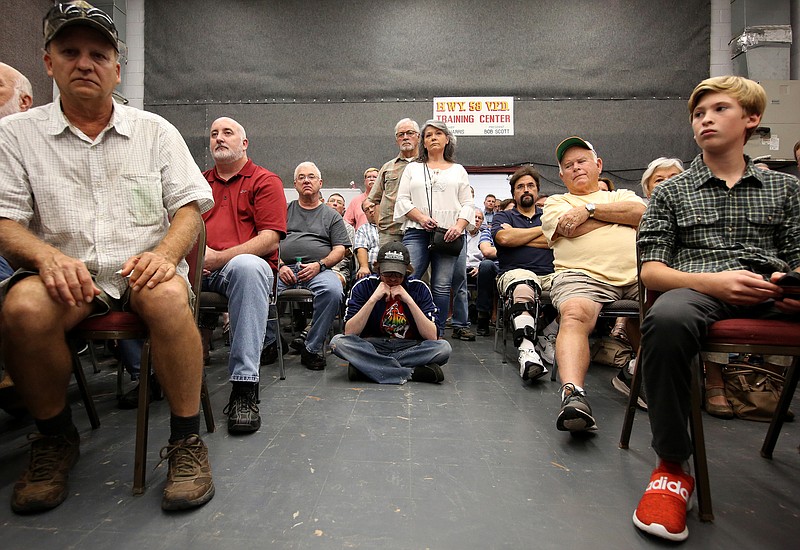A couple of hundred homeowners gathered Thursday night to start planning their counteroffensive against a planned sewage treatment plant on Mahan Gap Road.
The sanctuary of Meadowview Baptist Church was full and a few people leaned against the walls while Brent Smith, of North Heron Bay, and Dean Morehouse, whose property adjoins the proposed plant site, briefed them on steps so far and on what needs to happen next.
Many in the crowd had attended public hearings by the Hamilton County Water and Wastewater Treatment Authority, which says the $45 million plant would provide needed treatment capacity for the rapidly growing northeast portion of Hamilton County.
Furious homeowners in the North Ooltewah area don't dispute the need for the plant but want it placed somewhere other than their communities. Many spoke heatedly at public meetings about their fears of health impacts, wetlands contamination, sewer stink and loss of value in their most important investments, their homes.
Smith reminded the crowd of events since a single yellow rezoning sign appeared on Sept. 28, and how fearful and determined neighbors blew up the phones and social media feeds in opposition.
Thursday's meeting needed to be different, Smith said.
"We can use that time to complain about how we don't want it, but we've done that. Let's use the time to talk about how we can move forward, maybe get some suggestions about what can be done," he said.
"How many of you remember how you felt at that first meeting?" he asked. "I remember how I felt when I saw the yellow sign. That's the energy you need to draw from every day in this situation. Keep that energy and keep that pressure on. They go home from work every day. We don't. It's 24/7 for us."
Morehouse said representatives from the 14 subdivisions and eight non-subdivided communities are forming committees to tackle tasks ranging from circulating petitions and spreading the word on social media to investigating properties and looking at the law.
The biggest effort in the coming days, he said, has to come from those homeowners and their friends and neighbors, all loudly condemning any plant in their neighborhood and calling for an alternate site
"WWTA is not moving. This is their site. They're not backing down," Morehouse said.
The Hamilton County Regional Planning Agency will vote Nov. 12 whether to let the project go forward. Between now and then, he asked the neighbors to smother the planning agency staff, county commissioners and elected representatives with phone calls and emails against the plant.
Every person in the crowd got contact information for elected officials all the way up to Tennessee's senators, as well as the state environmental agency and the WWTA board.
Meanwhile, the committees will be coming up with an "accurate, referenced, hard to refute" presentation for the planning agency and, on Dec. 19, the Hamilton County Commission.
"When we do speak to WWTA and the county commission, we have nine minutes," Morehouse said. "We've got to make the best use of that nine mines. We have to have the best case as to why this needs to be moved somewhere else."
The WWTA says the site is best because it is low-lying and could make the best use of gravity to collect the waste. Moving it with electric pumps is a much more costly option, WWTA officials said.
But they enraged the property owners at Tuesday's public meeting when they said they had not done any sort of community impact study or calculated the potential loss in property values for the homeowners.
"What we're trying to do is make WWTA look foolish, because in my opinion they are," Morehouse said.
The homeowners also are deeply suspicious because developers sit on the WWTA and planning agency boards.
A property owner who was active in an anti-annexation citizens group said he thinks its going to take more than public pressure to stop the sewer plant.
"When you go to the Regional Planning Agency, everything is done in the back. It's a dog and pony show. The only way to stop this is to go to your wallet and find the best attorney money can buy," he said. "Everyone here is going to have to ante up, otherwise this plant's going to happen."
Contact staff writer Judy Walton at jwalton@timesfreepress.com or 423-757-6416.
